I am using STM32F429 CAN bus Program with TJA1041A as CAN Transreciver.The Problem is the messages are not getting acknowledged and herewith I am attaching the code for further reference.I am using PCAN View to see the messages.I kindly request to check the code and tell me if there are any faults.
Code:-
int main(void)
{
RCC_APB1PeriphClockCmd(RCC_APB1Periph_CAN1, ENABLE);
RCC_APB1PeriphClockCmd(RCC_APB1Periph_CAN2, ENABLE);
// SystemInit();
GPIO_InitTypeDef GPIO_InitDef;
RCC_AHB1PeriphClockCmd(RCC_AHB1Periph_GPIOB, ENABLE);
GPIO_InitDef.GPIO_Pin = GPIO_Pin_12 | GPIO_Pin_13;
GPIO_InitDef.GPIO_Mode = GPIO_Mode_AF;
GPIO_InitDef.GPIO_OType = GPIO_OType_PP;
GPIO_InitDef.GPIO_PuPd = GPIO_PuPd_UP;
GPIO_InitDef.GPIO_Speed = GPIO_Speed_100MHz;
GPIO_Init(GPIOB, &GPIO_InitDef);
/* Connect CAN pins to AF */
GPIO_PinAFConfig(GPIOB, GPIO_PinSource12, GPIO_AF_CAN2); // CAN2_RX
GPIO_PinAFConfig(GPIOB, GPIO_PinSource13, GPIO_AF_CAN2); // CAN2_TX
RCC_AHB1PeriphClockCmd(RCC_AHB1Periph_GPIOD, ENABLE);
GPIO_InitDef.GPIO_Pin = GPIO_Pin_5 | GPIO_Pin_7;
GPIO_InitDef.GPIO_Mode = GPIO_Mode_OUT;
GPIO_InitDef.GPIO_OType = GPIO_OType_PP;
GPIO_InitDef.GPIO_PuPd = GPIO_PuPd_NOPULL;
GPIO_InitDef.GPIO_Speed = GPIO_Speed_100MHz;
/* Connect PD5 and PD7 pins for CAN Transreceiver to enable and
stanby */
GPIO_Init(GPIOD, &GPIO_InitDef);
GPIO_SetBits(GPIOD, GPIO_Pin_5|GPIO_Pin_7);
RCC_ClocksTypeDef RCC_Clocks;
CAN_InitTypeDef CAN_InitStructure;
CAN_FilterInitTypeDef CAN_FilterInitStructure;
RCC_GetClocksFreq(&RCC_Clocks);
CAN_DeInit(CAN2);
CAN_StructInit(&CAN_InitStructure);
/* CAN cell init */
CAN_InitStructure.CAN_TTCM = DISABLE;
CAN_InitStructure.CAN_ABOM = DISABLE;
CAN_InitStructure.CAN_AWUM = DISABLE;
CAN_InitStructure.CAN_NART = DISABLE;
CAN_InitStructure.CAN_RFLM = DISABLE;
CAN_InitStructure.CAN_TXFP = DISABLE;
CAN_InitStructure.CAN_Mode = CAN_Mode_Normal ;
/* quanta 1+14+6 = 21, 21 * 4 = 84, 42000000 / 84 = 5000000 */
/* CAN Baudrate = 500Kbps (CAN clocked at 42 MHz) Prescale = 4 */
/* Requires a clock with integer division into APB clock */
CAN_InitStructure.CAN_SJW = CAN_SJW_1tq; // 1+6+7 = 14, 1+14+6 = 21,
1+15+5 = 21
CAN_InitStructure.CAN_BS1 = CAN_BS1_14tq;
CAN_InitStructure.CAN_BS2 = CAN_BS2_6tq;
CAN_InitStructure.CAN_Prescaler = 4; // quanta by baudrate - 125kbps
CAN_Init(CAN2, &CAN_InitStructure);
/* CAN filter init */
CAN_FilterInitStructure.CAN_FilterMode = CAN_FilterMode_IdMask; //
IdMask or IdList
CAN_FilterInitStructure.CAN_FilterScale = CAN_FilterScale_16bit; // 16
or 32
CAN_FilterInitStructure.CAN_FilterIdHigh = 0x0000; // Everything,
otherwise 11-bit in top bits
CAN_FilterInitStructure.CAN_FilterIdLow = 0x0000;
CAN_FilterInitStructure.CAN_FilterMaskIdHigh = 0x0000;
CAN_FilterInitStructure.CAN_FilterMaskIdLow = 0x0000;
CAN_FilterInitStructure.CAN_FilterFIFOAssignment = CAN_FIFO0; // Rx
CAN_FilterInitStructure.CAN_FilterActivation = ENABLE;
//CAN_FilterInitStructure.CAN_FilterNumber = 0; // CAN1 [ 0..13]
// CAN_FilterInit(&CAN_FilterInitStructure);
CAN_FilterInitStructure.CAN_FilterNumber = 14; // CAN2 [14..27]
CAN_FilterInit(&CAN_FilterInitStructure);
CAN_ITConfig(CAN2, CAN_IT_FMP0, ENABLE);
CanTxMsg TxMessage;
// transmit */
TxMessage.StdId = 0x321;
TxMessage.ExtId = 0x00;
TxMessage.RTR = CAN_RTR_DATA;
TxMessage.IDE = CAN_ID_STD;
TxMessage.DLC = 8;
TxMessage.Data[0] = 0x02;
TxMessage.Data[1] = 0x11;
TxMessage.Data[2] = 0x11;
TxMessage.Data[3] = 0x11;
while(1)
{
uint32_t i;
int j = 0;
uint8_t TransmitMailbox = 0;
TxMessage.Data[4] = (j >> 0) & 0xFF; // Cycling
TxMessage.Data[5] = (j >> 8) & 0xFF;
TxMessage.Data[6] = (j >> 16) & 0xFF;
TxMessage.Data[7] = (j >> 24) & 0xFF;
j++;
TransmitMailbox = CAN_Transmit(CAN2, &TxMessage);
i = 0;
while((CAN_TransmitStatus(CAN2, TransmitMailbox) != CANTXOK) && (i
!= 0xFFFF)) // Wait on Transmit
{
i++;
CAN2RX();// Pump RX
}
}
}
